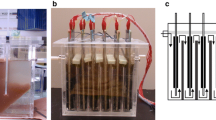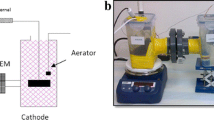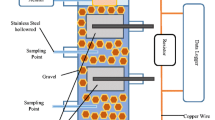Abstract
This study demonstrated the effectiveness of single chamber up-flow membrane-less microbial fuel cell (UFML-MFC) in wastewater treatment concurrently with bioelectricity generation. The objectives of this study were to examine the effect of influent substrate concentration (0.405 g/L, 0.810 g/L, 1.215 g/L, 1.620 g/L), anode distributions (11 cm, 17 cm, 23 cm ) and surface morphologies for biofilm formation on the performance of wastewater treatment and power generation. The optimum performance was obtained with substrate concentration of 0.810 g/L. The COD removal efficiency, output voltage, internal resistance, power density and current density obtained were 84.64%, 610 mV, 200 Ω, 162.59 mW/m2 and 468.74 mA/m2, respectively. The Coulombic Efficiency (CE), Normalized Energy Recovery (NERS and NERv) were 1.03%, 789.38 kWh/kg COD and 22.56 kWh/m3, respectively. The results also indicate that the output voltage and power generation obtained in a continuous up-flow MFC were higher with A3 (23 cm), which is of larger electrodes spacing followed by A2 (17 cm) and A1 (11 cm) caused by the enrichment of anaerobic microbial population at A1.






Similar content being viewed by others
References
Ahn Y, Logan BE. Altering anode thickness to improve power production in microbial fuel cells with different electrode distances. Energy Fuel. 2012;27(1):271–6.
Amari S, Vahdati M, Ebadi T. Investigation into effects of cathode aeration on output current characteristics in a tubular microbial fuel cell. Int J Environ Sci Technol. 2015;12:4037–42.
Angioni S, Millia L, Bruni G, Ravelli D, Mustarelli P, Quartarone E. Novel composite polybenzimidazole-based proton exchange membranes as ef fi cient and sustainable separators for microbial fuel cells. J. Power Sources. 2017;348:57–65.
Belafi-Bako K. Removal of COD by two chamber microbial fuel cells. In: Technology and application of microbial fuel cells Chapter. 2014;5:77–87.
Bond DR, Bond DR, Holmes DE, Tender LM. Electrode-Reducing Microorganisms That Harvest Energy from Marine Sediments. 2014:483.
Bond, P., Read, S. T., Dutta P, Bond PL, Keller J, Rabaey K. Initial development and structure of biofilms on microbial fuel cell anodes. BMC Microbiol. 2018. https://doi.org/10.1186/1471-2180-10-98.
Cecconet D, Molognoni D, Callegari A, Capodaglio AG. ScienceDirect agro-food industry wastewater treatment with microbial fuel cells : energetic recovery issues. Int J Hydrog Energy. 2017:1–12.
Chae K, Choi M, Lee J, Kim K, Kim IS. Bioresource technology effect of different substrates on the performance, bacterial diversity, and bacterial viability in microbial fuel cells. Bioresour Technol. 2009;100:3518–25.
Cheng S, Liu H. Increased power generation in a continuous flow MFC with Advective flow through the porous anode and reduced electrode spacing. Environ Sci Technol. 2006;40:2426–32.
Cheng S, Logan BE. Bioresource technology increasing power generation for scaling up single-chamber air cathode microbial fuel cells. Bioresour Technol. 2011;102:4468–73.
Dumas C, Basseguy R, Bergel A. Electrochemical activity of Geobacter sulfurreducens biofilms on stainless steel anodes. Electrochim Acta. 2008;53(16):5235–41.
Fang Z, Cheng S, Wang H, Cao X, Li X. Feasibility study of simultaneous azo dye decolorization and bioelectricity generation by microbial fuel cell-coupled constructed wetland : substrate effects. RSC Adv. 2017;7:16542–52.
Feng Y, Wang X, Logan BE, Lee H. Brewery wastewater treatment using air-cathode microbial fuel cells. Appl Microbiol Biotechnol 2008;78:873–80.
Ge Z, Li J, Xiao L, Tong Y, He Z. Recovery of electrical energy in microbial fuel cells. Environ Sci Technol Lett. 2014;1:137–41.
Hassan SR, Dahlan I. Performance of modified anaerobic hybrid baffled (MAHB) bioreactor treating recycled paper mill effluent: effects of organic loading rates. J Trop Resour Sustain Sci. 2018; 6:15–8.
Hernández-Flores G, Poggi-Varaldo HM, Solorza-Feria O, Ponce-Noyola MT, Romero-Castañón T, Rinderknecht-Seijas N, et al. Characteristics of a single chamber microbial fuel cell equipped with a low cost membrane. Int. J. Hydrogen Energy. 2015;40:17380–7.
Hodgson DM, Smith A, Dahale S, Stratford JP, Li JV, Grüning A, et al. Segregation of the anodic microbial communities in a microbial fuel cell cascade. Front Microbiol. 2016;7:1–11.
Hong L, Shaoan C, Logan BE. Power generation in fed-batch microbial fuel cells as a function of ionic strength, Temperature, and Reactor Configuration. Environ Sci Technol. 2005;39:5488–93.
Huang L, Logan BE. Electricity production from xylose in fed-batch and continuous-flow microbial fuel cells. Appl Microbiol Biotechnol. 2008;80: 655–64.
Kargi F, Dincer AR. Biological Treatment of Saline Wastewater by Fed-Batch Operation. 1997:50.
Karmakar S, Kundu K, Kundu S. Design and development of microbial fuel cells. Curr Res Technol Educ Top Appl Microbiol Microb Biotechnol. 2010;1029–1034.
Khater DZ, El-Khatib KM, Hassan RYA. Effect of vitamins and cell constructions on the activity of microbial fuel cell battery. J Genet Eng Biotechnol. 2018;16:369–73.
Kim KY, Chae KJ, Choi MJ, Ajayi FF, Jang A, Kim CW, et al. Enhanced Coulombic efficiency in glucose-fed microbial fuel cells by reducing metabolite electron losses using dual-anode electrodes. Bioresour Technol. 2011;102:4144–9.
Koupaie EH, Moghaddam MA, Hashemi SH. Post-treatment of anaerobically degraded azo dye acid red 18 using aerobic moving bed biofilm process: enhanced removal of aromatic amines. Journal of hazardous materials. 2011;195:147–54.
Lay CH, Kokko ME, Puhakka JA. Power generation in fed-batch and continuous up-flow microbial fuel cell from synthetic wastewater. Energy. 2015;91:235–41.
Lee CY, Huang YN. The effects of electrode spacing on the performance of microbial fuel cells under different substrate concentrations. Water Sci Technol. 2013;68:2028–34.
Lee Y, Oleszkiewicz JA. Effects of predation and ORP conditions on the performance of nitrifiers in activated sludge systems. Water Res. 2003;37:4202–10.
Li WW, Sheng GP, Liu XW, Yu HQ. Recent advances in the separators for microbial fuel cells. Bioresour Technol. 2011;102:244–52.
Lin H, Wu S, Zhu J. Modeling power generation and energy efficiencies in air-cathode microbial fuel cells based on Freter equations. Appl Sci. 2018;8:1983.
Liu H, Cheng S. Production of electricity from acetate or butyrate using a single-chamber microbial fuel cell. Environ Sci Technol. 2005;39: 658–62.
Liu Z, Liu J, Zhang S, Su Z. Study of operational performance and electrical response on mediator-less microbial fuel cells fed with carbon- and protein-rich substrates. Biochem Eng J. 2009;45:185–91.
Logan BE. Exoelectrogenic bacteria that power microbial fuel cells. Bioresour Technol. n.d.;101(6):1533–43.
López M, Santos V, Javier F, Valadéz R, Solís VM, Nava CG, Jacob A, Martell C, Hensel O. Performance of a microbial fuel cell operated with vinasses using different COD concentration. Revista Internacional de Contaminación Ambiental. 2017;33:521–8.
Lu N, Zhou S, Zhuang L, Zhang J, Ni J. Electricity generation from starch processing wastewater using microbial fuel cell technology. Biochem Eng J. 2009;43:246–51.
Min B, Cheng S, Logan BE. Electricity generation using membrane and salt bridge microbial fuel cells. Water Res. 2005;39:1675–86.
Mohan SV, Mohanakrishna G, Srikanth S, Sarma PN. Harnessing of bioelectricity in microbial fuel cell (MFC) employing aerated cathode through anaerobic treatment of chemical wastewater using selectively enriched hydrogen producing mixed consortia. Fuel. 2008;87(12):2667–76.
Mohan SV, Mohanakrishna G, Sarma PN. Effect of Anodic Metabolic Function on Bioelectricity Generation and Substrate Degradation in Single Chambered Microbial Fuel Cell. 2008a;42:8088–94.
Mohan SV, Mohanakrishna G, Srikanth S, Sarma PN. Harnessing of bioelectricity in microbial fuel cell (MFC) employing aerated cathode through anaerobic treatment of chemical wastewater using selectively enriched hydrogen producing mixed consortia. Fuel. 2008b; 87:2667–76.
Mohan SV, Raghavulu SV, Sarma PN. Biochemical evaluation of bioelectricity production process from anaerobic wastewater treatment in a single chambered microbial fuel cell (MFC) employing glass wool membrane. Biosens Bioelectron. 2008c; 23:1326–32.
Mohan SV, Saravanan R, Raghavulu SV, Mohanakrishna G, Sarma PN. Bioelectricity production from wastewater treatment in dual chambered microbial fuel cell (MFC) using selectively enriched mixed micro X ora : E V ect of catholyte. Bioresour Technol. 2008d; 99:596–603.
Moy BY, Tay J, Toh S, Liu Y, Tay ST. High organic loading influences the physical characteristics of aerobic sludge granules. Lett Appl Microbiol. 2002;34:407–12.
Oh S, Min B. Cathode Performance as a Factor in Electricity Generation in Microbial Fuel Cells. 2004;38:4900–4.
Oh SE, Kim JR, Joo JH, Logan BE. Effects of applied voltages and dissolved oxygen on sustained power generation by microbial fuel cells. Water Sci Technol. 2009;60:1311–7.
Oliveira VB, Simões M, Melo LF, Pinto AMFR. Overview on the developments of microbial fuel cells. Biochem Eng J. 2013;73:53–64.
Pant D, Van Bogaert G, Diels L, Vanbroekhoven K. Bioresource technology a review of the substrates used in microbial fuel cells ( MFCs ) for sustainable energy production. Bioresour Technol. 2010;101:1533–43.
Pennsylvania T. Electricity Generation Using an Air-Cathode Single Chamber Microbial Fuel Cell in the Presence and Absence of a Proton Exchange Membrane. 2004;38:4040–6.
Rabaey K, Lissens G, Siciliano SD, Verstraete W. A microbial fuel cell capable of converting glucose to electricity at high rate and efficiency. Biotechnol Lett. 2003;25:1531–5.
Rae J, Premier GC, Hawkes FR, Rodríguez J, Dinsdale RM, Guwy AJ. Bioresource technology modular tubular microbial fuel cells for energy recovery during sucrose wastewater treatment at low organic loading rate. Bioresour Technol. 2010;101:1190–8.
Rahimnejad M, Adhami A, Darvari S, Zirepour A, Oh SE. Microbial fuel cell as new technol ogy for bioelectricity generation: a review. Alexandria Eng J. 2015;54:745–56.
Reddy MV, Srikanth S, Mohan SV, Sarma PN. Bioelectrochemistry phosphatase and dehydrogenase activities in anodic chamber of single chamber microbial fuel cell ( MFC ) at variable substrate loading conditions. Bioelectrochemistry. 2010;77:125–32.
Reguera G, Nevin KP, Nicoll JS, Covalla SF, Woodard TL, Lovley DR. Biofilm and nanowire production leads to increased current in Geobacter sulfurreducens fuel cells. Appl Environ Microbiol. 2006;72(11):7345–8.
Reimers CE, Iii HAS, Westall JC, Alleau Y, Howell KA, Soule L, et al. Substrate degradation kinetics , microbial diversity , and current efficiency of microbial fuel cells supplied with marine plankton substrate degradation kinetics , microbial diversity , and current efficiency of microbial fuel cells supplied with marine. Appl Environ Microbiol. 2007;73(21):7029–40.
Rozendal RA, Hamelers HVM, Rabaey K, Keller J, Buisman CJN. Towards practical implementation of bioelectrochemical wastewater treatment. Trends Biotechnol. 2008;26:450–9.
Schröder U. Anodic electron transfer mechanisms in microbial fuel cells and their energy efficiency. Phys Chem Chem Phys. 2007;9 (21):2619–29.
Sherwood JE, Stagnitti F, Kokkinn MJ, Williams WD. Dissolved oxygen concentrations in hypersaline waters. Limnol Oceanogr. 1991;36:235–50.
Suthersan SS. Natural and enhanced remediation systems. Washington, DC: Acradis, Lewis Publisher; 2002.
Tamilarasan K, Rajesh Banu J, Jayashree C, Yogalakshmi KN, Gokulakrishnan K. Effect of organic loading rate on electricity generating potential of upflow anaerobic microbial fuel cell treating surgical cotton industry wastewater. J Environ Chem Eng. 2017;5(1):1021–26.
Taylor P, Prasertsung N, Ratanatamskul C. Desalination and water treatment effects of organic loading rate and operating temperature on power generation from cassava wastewater by a single-chamber microbial fuel cell. Desalination Water Treat. 2013;37–41.
Taylor P, Xiao Y, Roberts DJ. A review of anaerobic treatment of saline wastewater. Environ Technol. 2010;31:37–41.
Thung W, Ong S, Ho L. Simultaneous wastewater treatment and power generation with innovative Design of an Upflow Membrane-Less Microbial Fuel Cell. Water Air Soil Pollut. 2015;226(5):165.
Thung W, Ong S, Ho L, Wong Y, Ridwan F, Oon Y, et al. Sustainable green technology on wastewater treatment: the evaluation of enhanced single chambered up-flow membrane-less microbial fuel cell. J Environ Sci. 2017;1–6.
Toole GAO. Molecular basis of biofilm. Development by pseudomonads. 2004:43–63.
Wang X, Cheng S, Zhang X, Li X, Logan BE. Impact of salinity on cathode catalyst performance in microbial fuel cells ( MFCs ). Int. J. Hydrogen Energy. 2011;36:13900–6.
Wang X, Feng YJ, Lee H. Electricity production from beer brewery wastewater using single chamber microbial fuel cell. 2008;57:1117–22.
Watanabe K. Recent developments in microbial fuel cell Technologies for Sustainable Bioenergy. J Biosci Bioeng. 2008;106:528–36.
Xiao L, Ge Z, Kelly P, Zhang F, He Z. Bioresource technology evaluation of normalized energy recovery ( NER ) in microbial fuel cells affected by reactor dimensions and substrates. Bioresour Technol. 2014;157:77–83.
Yong X, Yan Z, Shen H, Zhou J, Wu X, Zhang L, et al. An integrated aerobic-anaerobic strategy for performance enhancement of Pseudomonas aeruginosa-inoculated microbial fuel cell. Bioresour Technol. 2017;241:1191–6.
Yu J, Cho S, Kim S, Cho H, Lee T. Comparison of Exoelectrogenic Bacteria detected using two different methods: U-tube microbial fuel cell and plating method. Microbes Environ. 2011;27:49–53.
Yu R, Liaw S, Chang C, Lu H, Cheng W. Online monitoring & control of colour removal process in textile wastewater. Water Sci Technol. 1997;35:57–66.
Zhang JN, Zhao QL, You SJ, Jiang JQ, Ren NQ. Continuous electricity production from leachate in a novel upflow air-cathode membrane-free microbial fuel cell. Water Sci Technol. 2008;57:1017–22.
Zhou M, Chi M, Luo J, He H, Jin T. An overview of electrode materials in microbial fuel cells. J. Power Sources. 2011;196:4427–35.
Acknowledgements
Maido Corporation Japan and Osaka Gas Chemicals Co. Ltd. is gratefully acknowledged by providing us with carbon felt.
Author information
Authors and Affiliations
Corresponding author
Additional information
Publisher’s note
Springer Nature remains neutral with regard to jurisdictional claims in published maps and institutional affiliations.
Rights and permissions
About this article
Cite this article
Tan, SM., Ong, SA., Ho, LN. et al. The reaction of wastewater treatment and power generation of single chamber microbial fuel cell against substrate concentration and anode distributions. J Environ Health Sci Engineer 18, 793–807 (2020). https://doi.org/10.1007/s40201-020-00504-w
Received:
Accepted:
Published:
Issue Date:
DOI: https://doi.org/10.1007/s40201-020-00504-w




